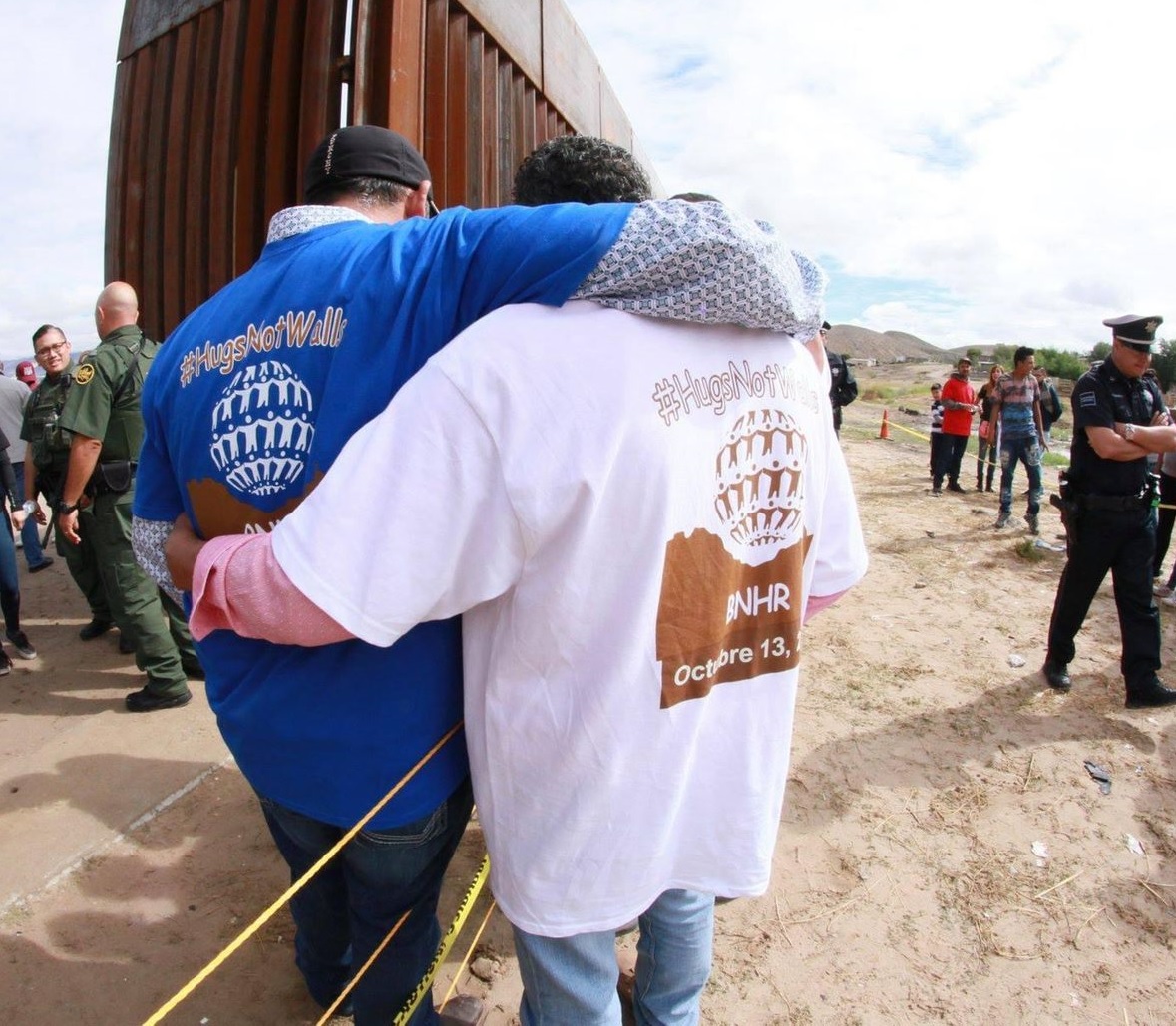“Abrazos, no muros”: entre la fronterización y la resistencia a la frontera en el límite México-Estados Unidos

Esta obra está bajo una licencia internacional Creative Commons Atribución-NoComercial-SinDerivadas 4.0.
Contenido principal del artículo
Contenido principal del artículo
Resumen
El artículo tiene por objetivo dar cuenta del ensamblaje y la tensión entre dos procesos opuestos, la fronterización y la resistencia a la fronterización. Con el fin de evitar la representación de ambos procesos, se aplica un enfoque teórico-metodológico inspirado en la teoría no-representacional. Para lograrlo se analiza un caso de estudio: “Abrazos, no muros”, una acción de resistencia realizada en el límite fronterizo entre México y Estados Unidos. El análisis del despliegue de ese evento, es decir, de las interacciones temporales entre múltiples cuerpos, objetos, prácticas, emociones, lugares y terrenos, muestra que está sujeto a una intensa representación y regulación fronteriza, a la vez que emergen vías de subversión imprevistas e incontrolables.
Detalles del artículo
Citas
Aikin, O. (2011). Activismo social trasnacional. Un análisis en torno a los feminicidios en Ciudad Juárez. Tijuana: El Colegio de la Frontera Norte.
Akers-Chacón, J. y Davis, M. (2006). Nadie es ilegal. Combatiendo el racismo y la violencia de Estado en la frontera Estados Unidos-México. Madrid: Editorial Popular.
Anderson, B. y Harrison, P. (eds.) (2011). Taking-Place: Non-Representational Theories and Geography. Londres: Routledge.
Bauder, H. (2012). Open Borders: A Utopia? Justice Spatiale/Spatiale Justice, 5. Disponible en http://www.jssj.org/article/un-monde-sa
Bauder, H. (2015). Perspectives of Open Borders and No Border. Geography Compass, 9(7), pp. 395-405, doi: 10.1111/gec3.12224
Boedeltje, F., Van Houtum, H. y Kramsch, O. T. (2007). The Shadows of no Man’s Land: Crossing the Border in the Divided Capital of Nicosia, Cyprus. Geographica Helvetica, 62, pp. 16-21, doi: 10.5194/gh-62-16-2007
Burridge, A. (2010). Youth on the Line and the No Borders Movement. Children’s Geographies, 8(4), pp. 401-411, doi: 10.1080/14733285.2010.511005
Burton, P. S. (2004). Hugging Trees: Claiming de Facto Property Rights by Blockading Resource Use. Environmental and Resource Economics, 27(2), pp. 135-163, doi: 10.1023/B:EARE.0000017276.60009.bf
Casey, E. S. y Watkins, M. (2014). Up Against the Wall: Re-Imagining the U.S.-Mexico Border. Austin: The University of Texas Press.
Campbell, H. y Heyman, J. (2007). Slantwise: Beyond Domination and Resistance on the Border. Journal of Contemporary Ethnography, 36(1), pp. 3-30, doi: 10.1177/0891241606287000
Ceniceros, B. (2019). La frontera como espacio de conflicto desde la cartografía emotiva. Graffylia. Revista de la Facultad de Filosofía y Letras, 4(7), pp. 22-35. Disponible en http://rd.buap.mx/ojs-dm/index.php/graffylia/article/view/435
Ceniceros, B. y Ettinger, C. (2019). Los puentes internacionales como elementos históricos de identidad fronteriza. Revista Interdisciplinaria de Estudios Latinoamericanos, 3(1), pp. 11-26.
Cisneros, J. D. (2011). (Re)Bordering the Civic Imaginary: Rhetoric, Hybridity, and Citizenship in La Gran Marcha. Quarterly Journal of Speech, 97(1), pp. 26-49, doi: 10.1080/13621025.2015.1075471
Coates, P. (2014). Borderland, No-Man’s Land, Nature’s Wonderland: Troubled Humanity and Untroubled Earth. Environment and History, 20(4), pp. 499-516. Disponible en https://www.jstor.org/stable/43299702
Corchado, A. (2018, 12 de mayo). Families separated by Trump policies briefly reunite before Mother’s Day for #HugsNotWalls. The Dallas Morning News. Disponible en https://www.dallasnews.com/news/mexico/2018/05/12/families-separated-trump-policies-briefly-reunite-rio-grande
Córdova, A. y De la Parra, C. (coords.) (2007). Una barrera a nuestro ambiente compartido: el muro fronterizo entre México y Estados Unidos. Tijuana: El Colegio de la Frontera Norte.
Córdova, A. y De la Parra, C. (coords.) (2012). El muro fronterizo entre México y Estados Unidos. Espacios, instrumentos y actores para un diálogo constructivo. Tijuana: El Colegio de la Frontera Norte.
Crowley, T. (2013). Climbing mountains, hugging trees: A cross-cultural examination of love for nature. Emotion, Space and Society, 6(1), pp. 44-53, doi: 10.1016/j.emospa.2011.10.005
D’Aoust, A. M. (2015). Moving Stories: Love at the Border. En L. Montegary y M. White (eds.), Mobile Desires: The Politics and Erotics of Mobility Justice (pp. 94-107). Basingstoke: Palgrave Macmillan.
De Genova, N. y Peutz, N. (eds.) (2010). The Deportation Regime: Sovereignty, Space, and the Freedom of Movement. Durham, NC: Duke University Press.
Dewsbury, J. D. (2010). Performative, non-representational and affect-based research: seven injunctions. En D. DeLyser et al. (eds.), The SAGE Handbook of Qualitative Geography (pp. 321-334). Londres: Sage.
Foucher, M. (1986). L’invention des frontières. París: Fondation pour les Etudes de Défense Nationale.
Galaviz, M. G. (2020). Border security infrastructure projects: space, access, and mobility in the San Diego-Tijuana Transborder Region (tesis doctoral). Austin: University of Texas at Austin.
González, E. (dir.) (2019). Un abrazo de tres minutos [película documental]. México / Estados Unidos: Netflix. Disponible en https://www.netflix.com/mx/title/80244679
Gordon, U. (2010). Against the Wall: Anarchist Mobilization in the Israeli-Palestinian Conflict. Peace & Change, 35(3), pp. 412-433, doi: 10.1111/j.1468-0130.2010.00641.x
Heuman, A. N. y González, A. (2018). Trump’s Essentialist Border Rhetoric: Racial Identities and Dangerous Liminalities. Journal of Intercultural Communication Research, 47(4), pp. 326-342, doi: 10.1080/17475759.2018.1473280
Holslin, J. (2011). Saving Friendship Park: A History of the San Diego Coalition Friends of Friendship Park. En J. Akers-Chacón y E. Dávalos (eds.), Wounded Border/Frontera Herida: Readings on the Tijuana/San Diego Border Region and Beyond (pp. 124-142). San Diego: City Works Press.
Jusionyte, I. (2018). Called to «Ankle Alley»: Tactical Infrastructure, Migrant Injuries, and Emergency Medical Services on the US-Mexico Border. American Anthropologist, 120(1), pp. 89-101, doi: 10.1111/aman.12967
Jones, R. (2011). Spaces of Refusal: Rethinking Sovereign Power and Resistance at the Border. Annals of the Association of American Geographers, 102, pp. 685-699, doi: 10.1080/00045608.2011.600193
Jones, R. (2016). Violent Borders. Refugees and the Right to Move. Londres: Verso.
Laine, S. (2011). Grounded globalizations of transnational social movements: Ethnographic analysis on Free Hugs Campaign at the World Social Forum Belém 2009. Ephemera. Theory & Politics in Organization, 11(3), pp. 243-257. Disponible en http://www.ephemerajournal.org/contribution/grounded-globalizations-transnational-social-movements-ethnographic-analysis-free-hugs
Lavrinec, J. (2011a). Revitalization of Public Space: From «Non-Places» to Creative Playgrounds. Santalka: Filosofija, Komunikacija, 19(2), pp. 70-75, doi: 10.3846/coactivity.2011.16
Lavrinec, J. (2011b). From a ‘Blind Walker’ to an ‘Urban Curator’: Initiating ‘Emotionally Moving Situations’ in Public Spaces. Limes: Borderland Studies, 4(1), pp. 54-63, doi: 10.3846/20290187.2011.577176
Leshem, N. y Pinkerton, A. (2016). Re-Inhabiting no-Man’s Land: Genealogies, Political Life and Critical Agendas. Transactions of the Institute of British Geographers, 41(1), pp. 41-53, doi: 10.1111/tran.12102
Longo, M. (2018). The Politics of Borders. Sovereignty, Security and the Citizen after 9/11. Cambridge: Cambridge University Press.
Lussault, M. (2007). L’Homme spatial. La construction sociale de l’espace humain. París: Seuil.
Merriman, P. (2012). Human Geography Without Time-Space. Transactions of the Institute of British Geographers, 37(1), pp. 13-27, doi: 10.1111/j.1475-5661.2011.00455.x
Merriman, P. (2022). Space. Londres: Routledge.
Mezzadra, S. y Neilson, B. (2017). La frontera como método, o la multiplicación del trabajo. Madrid: Traficantes de Sueños.
Miller, T. (2019). Empire of Borders. The Expansion of the U.S. Border around the World. Londres: Verso.
Moores, S. (2018). Digital Orientations. Non-Media-Centric Media Studies and Non-Representational Theories of Practice. Nueva York: Peter Lang Publishing.
Muñoz, G. E. y Gutiérrez, S. (2019). Desvanecimiento de la frontera como límite. Imaginario del borde como espacio público físico y virtual. Revista de Arquitectura, 21(2), pp. 33-43, doi: 10.14718/RevArq.2019.21.2.2133
Oliveras, X. (2016). Fiestas transfronterizas y representaciones espaciales en la frontera México-Texas. Economía, Sociedad y Territorio, 50, pp. 133-169, doi: 10.22136/est0502016762
Oliveras, X. (2019). La resistencia al muro de Estados Unidos: comparación de las espacialidades de ambos lados de la frontera. Ulúa. Revista de Historia, Sociedad y Cultura, 34, pp. 87-117, doi: 10.25009/urhsc.v0i34.2662
Parviainen, J. (2010). Choreographing Resistances: Spatial-Kinaesthetic Intelligence and Bodily Knowledge as Political Tools in Activist Work. Mobilities, 5(3), pp. 311-329, doi: 10.1080/17450101.2010.494838
Ravelo, P. (2004). Entre las protestas callejeras y las acciones internacionales. Diez años de activismo por la justicia social en Ciudad Juárez. El Cotidiano, 19(125), pp. 21-32.
Salazar, S. (2019). Las caravanas migrantes como estrategias de movilidad. Iberoforum. Revista de Ciencias Sociales de la Universidad Iberoamericana, 27, pp. 111-144. Disponible en https://iberoforum.ibero.mx/index.php/iberoforum/article/view/126
Simpson, P. (2021). Non-representational Theory. Londres: Routledge.
Skrede, J. (2020). Discourse analysis and non-representational theories in heritage studies: a non-reductionist take on their compatibility. Journal of Cultural Geography, 37(1), pp. 88-108, doi: 10.1080/08873631.2019.1662640
Soguk, N. (1996). Transnational/Transborder Bodies: Resistance, Accommodation, and Exile in Refugee and Migration Movements on the US-Mexican Border. En M. J. Shapiro y H. R. Alker (eds.): Challenging Boundaries: Global Flows, Territorial Identities (pp. 285-326). Minneapolis: University of Minnesota Press.
Staudt, K. (2008). Violence and Activism at the Border. Gender, Fear, and Everyday Life in Ciudad Juarez. Austin: University of Texas Press.
Stierl, M. (2019). Migrant Resistance in Contemporary Europe. Londres: Routledge.
Sundberg, J. (2015). The State of Exception and the Imperial Way of Life in the United States-Mexico Borderlands. Environment and Planning D: Society and Space, 33(2), pp. 209-228, doi: 10.1068/d14040p
Thrift, N. (2008). Non-representational Theory: Space, Politics, Affect. Londres: Routledge.
Vannini, P. (ed.) (2015). Non-Representational Methodologies: Re-Envisioning Research. Nueva York: Routledge.
Varela, A. (2015). Caravana de Madres Centroamericanas, un ejemplo de las nuevas luchas migrantes. En A. Estévez y D. Vásquez (eds.), Derechos humanos y transformación política en contexto de violencia (pp. 315-351). Ciudad de México: Universidad Nacional Autónoma de México / Facultad Latinoamericana de Ciencias Sociales.
Yeh, G. I. (2010). Wendy Yoshimura and the Politics of Hugging in the 1970s. Journal of Asian American Studies, 13(2), pp. 191-218, doi: 10.1353/jaas.0.0072








